Related Research Articles

Vsevolod I Yaroslavich, ruled as Grand Prince of Kiev from 1078 until his death.

Iziaslav Yaroslavich was a Kniaz' (Prince) of Turov and Grand Prince of Kiev from 1054.
Sviatoslav II Iaroslavich or Sviatoslav II Yaroslavich was Grand Prince of Kiev between 1073 and 1076. He was born as a younger son of Grand Prince Yaroslav the Wise, and became the progenitor of the Sviatoslavichi (Svyatoslavychi). His baptismal name was Nicholas.
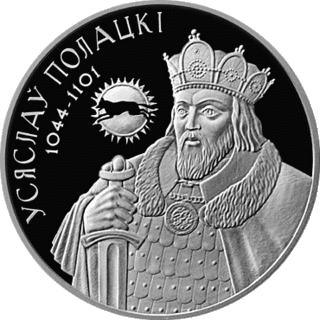
Vseslav of Polotsk or Vseslav Bryachislavich, also known as Vseslav the Sorcerer or Vseslav the Seer, was the most famous ruler of Polotsk and was briefly Grand Prince of Kiev in 1068–1069. Together with Rostislav Vladimirovich and voivode Vyshata, they created a coalition against the Yaroslaviches' triumvirate. Polotsk's Cathedral of Holy Wisdom is one of the most enduring monuments on the lands of modern Belarus and dates to his 57-year reign.
The family life and children of Vladimir I, popularly known as Vladimir the Great (c.958–1015), grand prince of Kievan Rus', is subject to scholarly studies. The primary sources about his life, such as the Primary Chronicle and the Chronicon Thietmari of Thietmar of Merseburg, are legendary, and require critical scrutiny to separate fact from fiction.
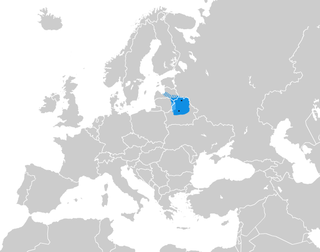
The Principality of Polotsk, also known as the Duchy of Polotsk or Polotskian Rus', was a medieval principality of the Early East Slavs. The origin and date of state establishment is uncertain. Chronicles of Kievan Rus' mention Polotsk being conquered by Vladimir the Great, and thereafter it became associated with Kievan Rus' and its ruling Rurik dynasty.
Rostislav Vladimirovich was a landless prince (izgoi) from the Rurikid dynasty of Kievan Rus’. He was baptized as Mikhail. According to the Russian genealogist Nikolai Baumgarten, the mother of Rostislav was Oda of Stade, a daughter of the Stade Count Leopold. That claim is also supported by other historians.
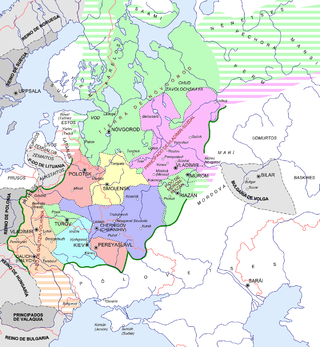
The inner Principality of Kiev was a medieval East Slavic state, situated in central regions of modern Ukraine around the city of Kiev (Kyiv).
The Battle of Alta River was a 1068 clash on the Alta River between Cuman army on the one hand and Kievan Rus' forces of Grand Prince Iziaslav I of Kiev, Prince Sviatoslav of Chernigov, and Prince Vsevolod of Periaslavl on the other in which the Rus' forces were routed and fled back to Kiev and Chernigov in some disarray. The battle led to an uprising in Kiev that briefly deposed Grand Prince Iziaslav. That incident supposedly shows the power of the Kiev veche and how common people gathering influenced princely politics in Kievan Rus'.
Bryachislav Iziaslavich was the prince of Polotsk between 1001 and 1044. His name, possibly, may have been of something in approximation to Vratislav or Wroclaw. He was son of Iziaslav of Polotsk. During his reign Polotsk was at war with Kiev and Novgorod. In 1015 he inherited the city of Lutsk after the death of his grandfather Vladimir I of Kiev.
The Kiev uprising of 1068 was a revolt against Grand Prince Iziaslav Yaroslavich of Kiev in the aftermath of a Kievan Rus’ defeat at the hands of the Cumans at Battle of the Alta River near the city of Pereiaslavl, southeast of Kiev.
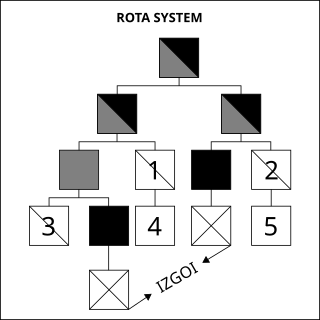
The rotasystem or the lestvitsa system was a system of collateral succession practiced in Kievan Rus', later appanages, and early the Grand Duchy of Moscow. In this system, the throne passed not linearly from father to son, but laterally from brother to brother and then to the eldest son of the eldest brother who had held the throne. The system was rationalised by Yaroslav the Wise, who assigned each of his sons a principality based on seniority, though it predates his reign and was also used among the Norse of Great Britain and Ireland.
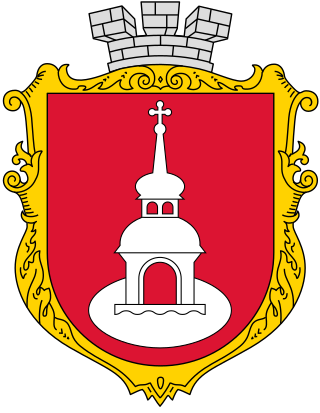
The Prince of Pereiaslavl was the kniaz of the Rus Principality of Pereiaslavl, a lordship based on the city of Pereiaslavl on the Trubezh river and straddling extensive territory to the east in what are now parts of Ukraine. It lay on Rus civilization's southern frontier with the steppe.
The Princes of Polotsk ruled the Principality of Polotsk within the realm of Kievan Rus' or within the Grand Duchy of Lithuania from the mid-9th century to 1307.
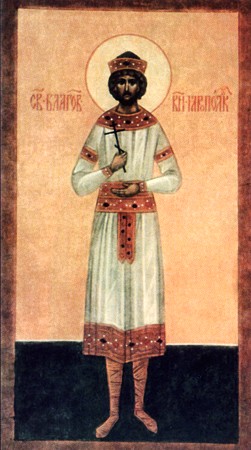
Yaropolk Iziaslavich or Yaropolk Iziaslavych was a Kniaz (prince) during the eleventh-century in the Kievan Rus' kingdom and was the King of Rus (1076–1087). The son of Grand Prince Iziaslav I of Kiev (Kyiv) by a Polish princess named Gertruda, he is visible in papal sources by the early 1070s but largely absent in contemporary Rus sources until his father's death in 1078. During his father's exile in the 1070s, Yaropolk can be found acting on his father's behalf in an attempt to gain the favor of the German emperors and the papal court of Pope Gregory VII. His father returned to Kiev in 1077 and Yaropolk followed.
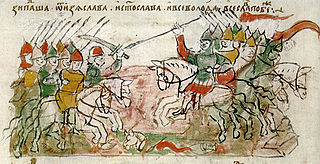
The Battle on the Nemiga River was a battle of the Kievan Rus' feudal period that occurred on March 3, 1067 on the Niamiha River. The description of the battle is the first reference to Minsk in the chronicles of Belarusian history.

The Council of Liubech was one of the best documented princely meetings in Kievan Rus' that took place in Liubech in 1097. The council ended the Chernihiv war of succession (1093–1097) between Sviatopolk II of Kiev, Vladimir II Monomakh and Oleg I of Chernigov who fought for the heritage of his father Sviatoslav II of Kiev.

The Rurikids or Riurikids also known as the Volodimerovichi, were a noble house allegedly founded by the Varangian prince Rurik, who, according to tradition, established himself in Novgorod around the year AD 862. After the conquest of Kiev by Rurik's successor Oleg the Wise in c. 880, the Rurikids established a dynasty over the state of Kievan Rus' until its disintegration in the 12th and 13th centuries. Over time, the reigning house split into many different branches, with distinct branches ruling regional centers. They continued to rule in many of the Rus' principalities which evolved out of Kievan Rus'.

The Principality of Turov, also called Principality of Turov and Pinsk or Turovian Rus', was a medieval East Slavic principality and important subdivision of Kievan Rus' since the 10th century on the territory of modern southern Belarus and northern Ukraine. Princes of Turov often served as the Grand Princes of Rus early in 10th-11th centuries. The principality's capital was Turov and other important cities were Pinsk, Mazyr, Slutsk, Lutsk, Berestia, and Volodymyr.
Monomakhovichi or House of Monomakh was a major princely branch of the Rurikid dynasty, descendants of which managed to inherit many princely titles which originated in Kievan Rus'. The progenitor of the house is Vladimir II Monomakh. The name derived from the grandfather of Vladimir, Byzantine emperor Constantine IX Monomachos of the Monomachos family.
References
- ↑ Dimnik, Martin (2006), Perrie, Maureen (ed.), "The Rus' principalities (1125–1246)", The Cambridge History of Russia: Volume 1: From Early Rus' to 1689, The Cambridge History of Russia, Cambridge: Cambridge University Press, vol. 1, pp. 98–126, ISBN 978-1-139-05410-2 , retrieved 2023-03-21
- ↑ Sergei Soloviev, Istorii Rossii s drevneishchikh vremen. 29 volumes in 15 books, vol. 1 (Moscow: Izdatel'stvo sotsial'no-ekonomicheskoi literatury, 1960), 346-348.
- ↑ A. D. Stokes, “the System of Succession to the Thrones of Russia, 1054-1113,” in R. Auty, L. R. Lewitter, and A. P. Vlasto, eds., Gorski Vijenats: A Garland of Essays Offered to Professor Elizabeth Mary Hill (Cambridge: Modern Humanities Research Association, 1970): 268-275; Nancy Shields Kollmann, "Collateral Succession in Kievan Rus," Harvard Ukrainian Studies 14 (1990): 277-287; Janet Martin, Medieval Russia 980-1584 (Cambridge: Cambridge University Press, 1995), 26-29.
- ↑ Russkaia Pravda, Expanded Version, art. 1.
- ↑ Martin, Medieval Russia, 29.
- ↑ Martin, Medieval Russia,96